|
| a place where stars are born |
|
|
| photo: nasa, hubble spacecraft |
Introduction
This is a work in progress. In fact, it's
not likely it will ever be finished, not because I'm lazy, though I may be, and not because I'm not smart enough to do the
work, although that may be true, too, but because this is not the kind of work that ever ends. Like keeping a journal
or building a better world, there's always more to do. But you do at least have to start somewhere, even if it's not
at the beginning, and even if there's no end you just kind of keep on going until . . .
CHAPTER 1
There are periods in history and prehistory when seemingly similar human activities
occurred simultaneously in greatly disparate parts of the globe. About ten years ago I mentioned those apparent chronological
coincidences to Rubellite Kawena Johnson, the brilliant Hawaiian scholar. She said, "Thats right! That's right!
Keep on doing what you're doing - you're on the right track."
I was pleased by her approval and intended to keep doing whatever it was I was
doing if I could figure out what it was I was doing or what "track" I was doing it on.
* * * *
It's unfortunate that when children are taught history in school that the importance
of celestial events in determining temporal life is ignored. Not only the normal and readily predictable behavior of
the stars, planets, sun, and moon, but the unusual or unexpected events such as comets, eclipses, conjunctions, and transits
had meaning and earthly consequences.
No, no, it's not what you're thinking - this isn't today's newspaper
astrology or someone channeling an ascended master or a coven of tie-died minds life-dancing on a higher
astral plane - this is the science of our ancestors.
Then again maybe it's appropriate that children don't learn the importance and
meanings of the sky. Their teachers don't know it, either, and neither do the writers of textbooks. After all,
the knowledge of the sky, except that needed by farmers and fishers and the like, was secret science, restricted
to priests and a tiny fraction of the ruling class.
Anyway, events in the sky are visible from widely separated parts of the globe.
A supernova, such as occurred on the fourth of July in 1054, or a comet such as Halley's Comet, or a triple conjuction, is
seen in all four hemispheres. (An aside - 4 hemispheres, harumph. But there you have it - 4 half globes, when
of course we all know 4 halves don't make a whole, but then this isn't math, is it?) And because priests and rulers
"read" the stars, they knew that celestial events were messages and omens upon which the village/tribe/nation should
act.
Hence, because the same celestial events were observed in all four corners of
the globe, peoples everywhere simultaneously reacted, and often in remarkably similar ways. (Here's another one of those oddities - a globe is a sphere, is it not? A sort of three-dimensional circle,
right? So how can a globe have four corners, or, for that matter, any corners at all?)
| chumash (california) |
|
|
| midwinter standard |
Yearly celestial cycles likewise had, in the case
of ancient no-longer extant cultures, and have, in the case of contemporary traditional and tribal cultures, simultaneities
and similarities, even if the original causes and effects are forgotten. Thus the plethora of ritual and festival
events at the winter solstice and spring equinox, including Christmas/Hannukah and Easter-Passover in the modern West.
In some Northern American indian cultures there
are practitioners of Bear Medicine, associated, among other things, with the immense power of bears. But Bear Medicine
typically cannot be practised between winter solstice and spring equinox.
Why? Well, the bear goes into its cave and
hibernates.
As above, so below. At this quarter of the
year - winter solstice to spring equinox - the constellation Bear, Ursa Major, the Great Bear whose stars encompass the whole
of the Big Dipper and more, drops to its lowest point in the sky, just barely above the horizon. Ursa Major has
gone into hibernation.
And, not exactly as a by-the-way, the name Arthur
means Bear. And anywhere the Great Bear constellation was observed it was recognized as a ruler or sacred or at the very
least an exceedingly powerful being.
Ursa Major sits "above" the ecliptic, that girdle of 12 constellations
that make up the 12 signs/houses of the zodiac. And, although this seems irrelevant right now, in the archaic language
of priests/astronomers/poets-singers the earth was often called a table.
| the band/belt of |
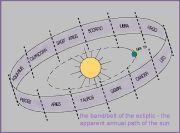
|
| the zodiac |
Arthur and his Twelve Knights sat at the Round Table.
Arthur - the Bear - was the 13th man, the administrator or law- or rule-maker (the ruler) of the Round Table
(earth) and the 12 Knights, each of whom was one of the twelve constellations of the zodiac.
##########################################################################################################
__________________________________________________________________________________________________________
ok. I've been trying, with absolutely no success,
to approach putting material on this site in a reasoned, orderly, and logical way. As I just said, I've failed.
So, for now anyway, I'm just gonna get on with it, all out of order and everything,
and trust that when the clutter piles high enough some kind of organization will emerge.
Pardon the mess on the floor, then. I just gotta begin, if not at the
beginning, somewhere.
::::::::::::::::::::::::::::::::::::::::::::::::::::::::::::::::::::::::::::::::::::::::::::::::::::::::::::::::::::::::::::::::::::::::::::::::::::::
^^^^^^^^^^^^^^^^^^^^^^^^^^^^^^^^^^^^^^^^^^^^^^^^^^^^^^^^^^^^^^^^^^^^^^^^^^^
Creation and procreation
are pretty much the start of it all. Not only how each of us came to be, but how we see, or at least our ancestors saw,
the universe and the patterns within it.
The numbers 1, 2, and 3 relate to creation/procreation. One is whole,
two is duality, three is the triad that stablizes. It's also man, woman, child; chaos/the void/potentiality/darkness/unity,
form/light/manifestation/duality, reunion/friction/creation.
It's the single most important and sacred phenomenon in our universe -
without it we wouldn't be here and there wouldn't be plants and fish and animals to sustain us even if we were somehow
here.
___________________________________________________
There's an island in the Hawaiian chain called Kaho'olawe. Its name in
earlier times was Kohe Malamama O Kanaloa, translated using Pukui's
dictionary as The shining vagina of Kanaloa, but generally phrased as The shining beacon of Kanaloa.
Kohe is, among other things, a mortise. And
it's not a vagina, a minor mistranslation, but, rather, a vulva. The upright(s) support(s) for the steering paddle(s)
on a Hawaiian voyaging canoe is/are Y-shaped, open at the top, a kohe, as it were. Malamalama means bright and
shining and it also means care for, stewardship, and it also means enlightened knowledge. The navigator is the steward/caretaker
of the canoe because he has the knowledge of navigation. The bright and shining refers to a star. Kanaloa
is the god of the ocean, the god of the underworld, and in his octopus "body form" is the navigator's symbolic guide through
the Pacific Ocean. Kana alone means 10s, so maybe decans, and loa means long, far, as maybe in horizon. Canopus
is a greenish star. Greenish light is the color of Kanaloa's underworld realm. One of the Hawaiian names for Canopus
is Ke ali`i o kona lewa, The chief of the southern heavens. And if one is aboard a canoe at the western end of
Kaho`olawe, Canopus is a guiding star that takes you to Tahiti.
And then . . .
. . . there's a whole lot more to Kohe malamalama o kanaloa.
Canopus is a voyager/navigator's meaning for the island's old name, esoteric
enough, but it's not the deeper meaning.
Every year, beginning in October, the Hawaiian Makahiki Festival period
begins and it lasts until February/March, encompassing the months of Hawaiian winter (only two seasons in the Islands - summer
and winter). Makahiki is the annual New Year's series of ceremonies and throughout the period rituals are dedicated
to the god Lono who, in his form as Lono-i-ka-Makahiki, sails away from Hawai`i and to Kahikilani (the distant heaven) at
the end of the Makahiki period.
Lono shares qualities with gods in other cultures who likewise leave and then
return to leave again - Kukulcan and Quetzlcoatl in Central America, for example, and Osiris of ancient Egypt, and Jesus of
Christian peoples. They are born in midwinter, more precisely at the winter solstice, in our era occuring on December
21, at which time the sun is said to "stand still" and then, on December 23 to begin to move again.
As the year enters deep winter, the days grow shorter. The day of winter
solstice is the shortest day of the year, and the night the longest night of the year. For two days it looks as though
the sun doesn't move - it appears to rise and set at exactly the same points on the horizon each day. On the third day
the sun rises - is reborn - at a new point on the horizon.
The event that triggers Hawai`i's Makahiki is the rise of the constellation
Makali`i - the Pleiades. And when the Pleiades rise, on the far side of the Milky Way near the Hawaiian constellation
Manaiakalani - Maui's fishhook - in the tail of Scorpio, there's a valley, a gap, a rift or cleft in the Milky Way.
At the left is a map of the Milky Way.
You can see the dark rift or cleft, which in this image is white while the Milky Way itself is in blue.
The constellations Scorpio and Sagittarius are in red, and the ecliptic is purple.
(This map was created using Skyglobe, a shareware skymapping program available
online. If you type Skyglobe into your search engine you'll find a good number of sites from which you can download
the program. I got mine at http://www.eaaa.net/download.htm
I used Honolulu on Friday January 14 2005 at 16:43 hours, not because it's auspicious but
because I messed up when I tried to print a version I made for December 21 c. 1000 AD.)
The cleft, actually a dense dark cloud, is, as are caves on earth, an opening
into another realm. It's also a kohe, a vulva and vagina, the entrance to the swelling area - the cosmic womb so
to speak - where stars are born, or, in the meaning within kohemalamalamaokanaloa, to the realm of ancestors and the
unborn, the realm, in other words, of Kanaloa.
But a womb, even a celestial and cosmic womb, doesn't produce children without
mating.
Lono Makua is the mate, symbolized by a carved image at the top of the Makahiki
pole.

This is a Lono Makua image. His name
- Lono Makua, Father Lono - refers to his "fathering," as a parent and as the force that enters to fertilize
the egg, the seed, of the child his successor.
The symbolism goes farther than that, though. Lono Makua is a fire god,
keeper of the fire sticks and maker of fire. Fire sticks and making fire are metaphors for sex.
So, Lono Makua fathers. Fathers what/whom? He fathers the sun, or
more exactly as the Sun he fathers the Son of the Sun.
As a fire god, keeper of the fire sticks and starter of fire, Lono Makua is
the sun or sun god. During Makahiki he symbolically enters the cosmic womb, impregnating her, and she gives birth to
the new sun - the son of the sun - who will himself in a year be Lono Makua and like his father before him impregnate the
cosmic womb and die.
He's also present and his sexual and fertilizing nature is enjoyed by the people
at the festival in what writers refer to as an orgy of sexual abandon. Words like "orgy" make me a little nervous.
They may be intended to make an objective statement, but inevitably they seem disparaging and judgmental. ("Shaman"
is another one of those words.)
Anyway, for a night after the lighting of the bonfire the people are free to
have sex with whomever they wish to. This sexual expression of the year's end/new year appears in ancient Greece, in
ancient Babylon and Egypt, in dozens of other cultures, and it appears in both the Hopi and Hawaiian cultures at a second
time of year in a much less well known and considerably more kapu and private manner. We'll get to that in a while.
Near the end of the Makahiki period the old god - Lono Makua - is killed in
a ritual spearthrowing by a Hawaiian spear-thrower who throws a spear at the ali`i nui, the god's earthly representative.
"The King is dead! Long live the King!"
| lono-maka-'ihe |
|
|
| hawaiian spears |
It's a ritual carried out in ancient and traditional
cultures around the world.
Sort of as a by the way, the word for art of spear-throwing - lonomaka'ihe -
when spoken aloud sounds faintly like Lonoikamakahiki.
The word "maka" standing alone has several meanings germane to the solstice
season:
- the most widely known meaning is eye(s), but maka also means the mesh of a
net, and during Makahiki nets play a part
- maka also means beginning, as, for instance, of a new year
- it also means new plants shoots coming up through the ground, relating maka
both to Lono as agriculture/fertility god and to the Makahiki as the start of a new growing season.
- it also means fishhook, and that takes us back to the night sky, to Maui's
fishhook in the tail Scorpio at the entrance to the dark cleft, the Kohe leading into Kanaloa's realm
We're not done yet -
The circuits of the Long God and the Short God.
The Akua Loa is carried on a circuit around the island. The Akua Poko makes a circuit of each ahupua'a (land section).
The circuit of the Long God represents the annual cycle of the sun.
The circuit of the Short God represents the 24-hour cycle of the sun.
The pole and crosspiece. Crosses appear in ancient
and modern cultures around the world. They also appear in the sky.
There are constellations that are crosses, but they aren't the celestial crosses
represented by sacred and ceremonial crosses on earth. Earthly crosses represent more important heavenly crosses - the
X of the line running between equinoxes and the line between solstices, and, in the case of the Makahiki's cross the crossing
of the ecliptic with the Milky Way.
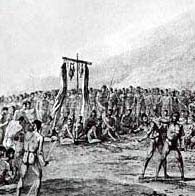
|
| makahiki pole |
The hale wai ea. The ceremony
in the hale wai ea (in which only the kahuna nui - high priest - and the ali'i nui - high chief - were present) at Makahiki
included reconciling/intercalating the calendar for the coming year. Neither the lunar calendar nor the anahulu calendar
nor the solar calendar added up to an absolute year - there were days left over or under and they had to be reckoned with.
The anahulu count was 36 ten-day weeks, five and a quarter days short. The lunar calendar of 28 and a fraction days
per month didn't and doesn't match the solar calendar, and the solar calendar didn't and doesn't account for the 1/4 day.
The pu ea. There was another ritual as well.
This involved a human skull as a cup filled with water - the wai (water) ea (water of life of the nation/sovereignty).
The skull is the pu ea, the shell/container, that held the wai ea.
Valerio Valeri's book, Kingship and Sacrifice, says that the bonfire
was dedicated to an unknown god called Puea. (There is, however, a connection between the bonfire and the skull.)
This ritual involved, at least in part, the symbolism of the interrelationship
and interdependence of life and death - in death there is life, on earth as it is in heaven.
Although a skull may seem macabre, its intent in the ritual is anything but.
Its mystical function echoes the myths and legends in which a hero descends to the Underworld to revive someone or learn something
or bring something back to the land of the living.
Use of a skull or skulls takes place in many cultures. In our Western
Christian culture the place of the skull (which is what Golgotha means) is taken by the goblet/grail at the Last Supper wherein
the disciples symbolically drank Jesus's blood, just as we do at communion in church today.
Tibetan Buddhism and at least one sect of Indian Hinduism to this day use a
skull cup.
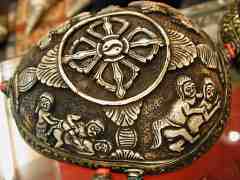
this is a Tibetan skull cup, upside down to show
the intricate carving - and note that the carvings
include figures of people engaged in sex acts -
death-life/skull-procreation
| aztec |
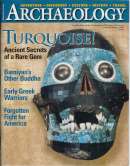
|
| skull with turquoise overlay |
Throughout the world and down the milennia initiations
into the realms of the temporal elite and sovereign classes have involved ritual symbolic descent into darkness and death followed
by resurrection and return to life. In a great many of these initiations skulls or skulls and thigh bones
play a part.
One of the things this particular ritual does is sanctify/deify or reinforce
the sanctity/deification of the king/mo'i/ali'i nui and his kahuna, both through their experience of the ritual and through
everyone else's experience of exclusion from the ritual.
_______________________________________________________
*******************************************************
There's something else, and it's a bit of a historic oddity. In the very
long ago, 2,500 and more years before present, the greatest gods were either distant uninvolved organizing forces or creating
gods. They were not only immortal, they were never mortal.
But around 2,500 years ago a new kind of great god began to manifest.
This god was not the creative god who made earth or humankind. This god appeared when creation was already made, and
he had some attributes the organizing and creating gods didn't have.
The first of these resurrecting gods was Osiris, although he was a very early
member of the group, probably the first, and there are some who believe the deified Osiris was first a king of very early
Egypt.
These gods , and as far as I've yet found they're always male, are mortal,
born of a human mother who was impregnated by either the sun as god or by a deified force emanating from a god. This
god lives on earth as a man, complete with human qualities and frailties. In his earthly lifetime he occupies
actual time and place, or is at least believed to have occupied real time and place, and his coming is recounted as fulfillment
of prophecy.
The ancients of the classical world expected a savior and looked hard for him.
Pythagoras, contemporary with Gautama Buddha, was believed by some to be the prophesized savior. Obviously, in India
Siddhartha Guatama was understood to be the savior. There was, of course, Jesus in the Middle East. In Central
America there was Quetzlcoatl/Kukulkan. And in Hawai'i there was Lono-i-ka-makahiki, possibly at the same time, as there
have been several Lono-i-ka-makahikis. Although it was six hundred years later that Mohammed lived, it may be that he,
too, was one of these mortal immortals.
Later, around 1390, another mortal-born savior appeared, Deganawida, who through
his spokesman Hiawatha traveled the Northeast among the Iroquois nations proclaiming
the Good News of Peace and Joy. If that sounds familiar it's because nearly the same words are used in the New
Testament of Christianity and were, in fact, the opening words of Hiram Bingham's first sermon upon his arrival in Honolulu
in 1820.
The word Lono has among its meanings "news, report, tidings," and Lonohonua
means "to hear surprising or sudden news." It's probably not coincidental that honua also means the earth.
Another interesting thing about the savior gods - except for Deganawida/Hiawatha
about whom I've not seen any astronomical reference - all of these gods are associated with the star Sirius. And
in Hawai'i, one of the names for Sirius is Lono.

At left is a NASA photo of Sirius. It's actually
in a field of stars, but because I had to reduce the size of the photo and its compression you can only see Sirius.
That does give you, however, some impression of just how bright a star Sirius is, as compressing the image makes the
other stars disappear while Sirius is still a bright light.
There's an interesting quality to Sirius. It
changes color. It's sometimes red, sometimes white, sometimes blue. In mythology, generally speaking, it is blue
and the savior/revivifying gods associated with it are sometimes refered to as "blue gods." The Hopi name for the star Sirius is Saquasohuh (Blue Star).
There's something more here. George Byron's
1826 book, The Voyage of the H.M.S. Blonde to the Sandwich Islands, quoted in Beckwith's Hawaiian Mythology, relates
his translation of what he called "The Song of Lono" -
Having instituted games to commemorate her death, he [Lono] embarked in
a triangular boat (piama lau), and sailed to a foreign land.
Ere he departed he prophesied, "I will return in after times, on an island
bearing coconut trees, and swine, and dogs.
Triangular boat? What's a triangular boat? Is it a constellation?
I'm presuming it is a constellation, perhaps one that "carries the sun."
The parenthetical - piama lau - what might this mean? Piama isn't in Pukui's
dictionary, but pi and ama are.
Pi means smoldering, sputtering as a waning fire might. And pipi
has a meaning of twinkling, as stars.
Ama is the float on an outrigger canoe.
Lau means many, 4 hundred, pattern, and a kind of net.
My guess is that the piama lau, the triangular boat, is a constellation or
perhaps part of the Milky Way that is to the celestial west or south of the kohe. It might even be the boat constellation
that has Canopus as one of its stars.
//////////////////////////////////////////////////////////////////////////////////////////////
.........................................................................................................................................................................
This - what is it? - mythoastronomy? cosmology?
? Grandpa Ho'okano called it my "study of Hawaiian things," but it's not just Hawaiian. In fact the more I learn
the more universal it reveals itself to be. Anyway, it's a trail you can't walk in a straight line.
Or in a hurry.
One thing leads to another and another and another and I don't think you can
plan the trip. Anyway I can't. You just get on and go.
I don't know what I was googling when I found this site. And I didn't
realize on the first visit how important a book Mr. Buffalo's words make. I just bookmarked the site and ran off to
look for something else.
One day I was reading something and the word "traditionalism" was in it.
It wasn't a familiar word, but it had "traditional" in it so I googled it.
Yikes. Not at all what I expected. Not a bad thing, just not
at all what I expected. This traditionalism refers to universal esoteric and initiatory spiritual traditions of
ancient civilizations and some contemporary cultures. Things like the Makahiki festival's Hale Wai Ea ceremony,
for instance, where the king/chief is ritually re-initiated through, oh pardon me for the bubble-brained language I'm using
here, the actions and symbols of death - darkness, the skull - and rebirth - emerging from the "womb" that is the Hale
Wai Ea.
Anyway, visiting traditionalism introduced me to some writings and writers with
which I was unfamiliar, so I looked some of them up, too. And I discovered that a couple of people whose works were
familiar - Mircea Eliade and Huston Smith, for example - appeared among the traditionalist writers.
I read a few biographic notes about Mircea Eliade and I was really bothered
by something - somehow his traditionalism led to his sympathy for, perhaps support of, racist facism, specifically of the
then young German Nazi movement.
How does universal esotericism, universal initiatory practice, feed racism?
I don't get it.
But I do get it. It's the initiation part, the exclusivity by means of
initiation. The inner teachings may be universal, but only the initiated elect are qualified to know them.
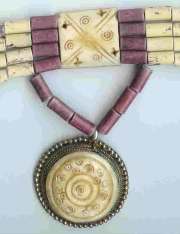
The picture to the left is of the center part of
a choker made of wampum beads and incised bone. There's all kinds of symbolism here.
First, it tells you it's American Indian. Then the wampum tells you the
general regional tradition area the idea for the choker comes from - northeast U.S., southeast Canada. Then the designs
carved in the bone pieces stand for things, too. The little x-shapes with a hole in the middle are stars.
The big X on the square bone piece is a form of a cross and the cross is in the sky, not on the earth. And so on.
And it's also just a necklace.
So this initiation thing, it doesn't change the meaning of a symbol, but it
adds additional meaning/meanings, at each level of initiation more esoteric and thus more sacred and more secret.
It gave me the willies to know that things I know
to be sacred can also be evil. Actually, they're not evil, but they can be used for evil.
And in fact I already knew that because it's part of Hawaiian culture, too,
and other native cultures. The knowledge and the mana/power is potent, that is possession of it is to possess its potential
and how you exercise that potential, how you manifest it, is what makes it good or evil or indifferent.
Still, I guess I expected better from someone whose works I admire.
The traditionalists exclude a great many people right off the top because of
the way they use language. It's dreadfully overdone language, philosophers' language:
"Philosophy, considered from the standpoint of its limitations - and it is the limitations of
philosophy that confer upon it its specific character - is based on the systematic ignoring of what has been stated above.
In other words, philosophy ignores what would be its own negation; moreover, it concerns itself solely with mental shemes
that, with its claim to universality, it likes to regard as absolute, although from the point of view of spiritual realization
these schemes are merely so many virtual or potential and unused objects, insofar at least as they refer to true ideas; when,
however this is not the case, as practically always occurs in modern philosophy, these schemes are reduced to the condition
of mere devices that are unusable from a speculative point of view and are therefore without any real value."
That's from the first chapter of traditionalist Frithjof
Schuon's book The Transcendent Unity of Religion.
"And if there's a person who has something that he carried good, and if he leaves
me with that good word and tells me what to do with it, that's a big gift. Really, it's a big gift! You stop for
that. You've got to go along with what he did, because he gave you a good word. He gave you a good stone to carry
in your pocket. Sure, you stop and look at it, put it in your pocket and go along on your way. It's a big thing.
You have to carry something on you...
...the older the world gets, the more dangerous it is...
...There is a thing behind that sun. There is a thing. If it isn't
behind the sun, it's somewhere. One of the stars has it, maybe the moon's got it, behind it. But watch that light.
When that light shines, it serves you...
...Indians sing for power, they fast, and they talk to the birds and trees,
telling them what their medicine's for....Ya, talk to the trees. That's what you do, and it's almost then that your
power commences. Then you got power...
...The sun is a great thing...Stars! Stars are great too. Yeah,
that's something. It's a great earth, and there's miles and miles of it. There's miles and miles of sun too.
The Great Manitou is back of the sun, and He'll take care of that sun."
Those are a few of Paul Buffalo's words. And they're easy words.
Anyone can understand them. And his words are as deep, as profound, as esoteric as the alphabet people's. How
can that be?
Because the words Paul Buffalo uses let you understand, let you realize, as
much as your experience and knowledge of the moment enables you to. Ten people hear the same words at the same time,
but there isn't just one meaning - there are ten meanings, eleven really, counting the speaker who says the words.
Back to the Traditionalists. Rene Guenon (1886
- 1951) is the philosopher most intimately associated with Traditionalism. He was French and wrote in French and only
a few of his works have been available in English. From what I glean from the little I've read by and about him, he
viewed the arc of human spiritual history to have been a devolution/disintegration moving from Form (or Quality) to Matter
(Quantity) which will soon more or less implode (at the end of the current World Age) in an "inversion" of quality and consequent
reign of an Antichrist.
What he calls the Reign of Quantity, the state we're in, is guided by the effort
to quantify all of reality to measures countable only by the five human senses, discounting altogether the mysteries of insight,
revelation, inspiration, intuition, and the spirit.
It's hard to find argument with that.
OOOOOOOOOOOOOOOOOOOOOOOOOOOOOOOOOOOOOOOOOOOOOOOOOOOOOOOOOOOOOOO
xxxxxxxxxxxxxxxxxxxxxxxxxxxxxxxxxxxxxxxxxxxxxxxxxxxxxxxxxxxxxxxxxxxxxxxxxxxxx
I think this is a good place to talk a little about the
symbols of the language of myth.
There's ample evidence that our long ago ancestors did not think the
earth was flat. Seagoing peoples were well aware of earth's curvature from observing objects approaching them from the
horizon and from observing objects on the horizon as the seagoers sailed, drifted, or paddled toward the horizon. Presumably
desert travelers noticed the same phenomena.
In myths the earth is flat, not because the makers of myth believed it was flat,
but because a flat earth lends itself more conveniently to symbols and metaphors.
Our ancestors did, however, believe that the earth was the center of the universe
and that the sun and moon and planets and stars all revolved around the earth.

this is the flat earth
and X marks the spot
you're standing on
For most purposes in the symbolic language the earth is conceived as a flat
rectangular plane. In some stories, though, like the King Arthur stories, the earth is a flat circle.
Now think of the earth in the middle of the universe. There's space above
and space below.

Here's the ball of earth
suspended in the middle
of the universe.
In some creation stories, like the Hindu stories and the Polynesian stories
in which Kanaloa is the creator, the infant universe is a "cosmic egg." There's a reason for that - the egg works beautifully
as a visual metaphor for the relationship of earth to the universe, and the opening of the egg at the middle, well it accomplishes
the same thing King Arthur's Round Table does - a circle around a center, or the sky/universe around the earth.
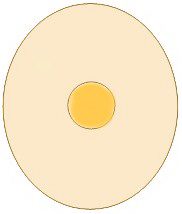
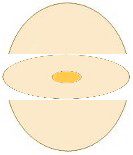
We'll leave egg for now, but you can see how well
it works as a model of the earth within the universe.

So, the flat earth in a flat plane. There is
the "sky above," often called the "heavens." And there is the "sky below," often called the "underworld."
The sky above is connected to the sky below by an axis the goes through the
center of the earth.
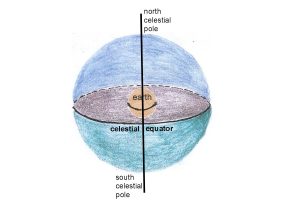
The top of the axis is the North Pole and the bottom
the South Pole, and the sky, like the earth, rotate around the pole.
But the earth's isn't pole isn't straight up. It's at an angle.

The sun makes a path around the earth. We call
that path the ecliptic.
The ecliptic is also the band in the sky that contains the twelve
constellations of the zodiac. That means that the sun passes through each constellation during its yearly journey
around the earth.
The sky, you'll notice, like the earth, has an equator.
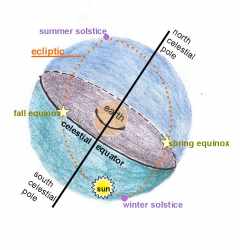
The places where the ecliptic crosses the equator
are the equinoxes - the two times each year, one in the spring and one in the fall, when night and day last an equal number
of hours.
Two other important solar path days are the solstices. The summer
solstice takes place when the sun is at its greatest distance from earth. This day is the longest day of the year.
The winter solstice takes place when the sun is closest to the earth.
This is the shortest day of the year.
Each of these four sun events occurs in a predictable pattern of star movement
along the horizon and for milennia before our era people watched the sky to prepare for the solstices and equinoxes.
And the four constellations in which the sun rose at equinox and solstice dawns are the pillars/posts/supports of heaven -
for a while.
click here to jump to the next page - a short history part 2
|

